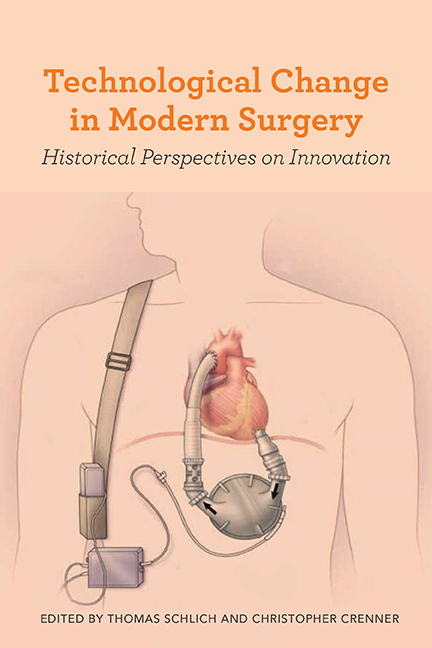Book contents
- Frontmatter
- Dedication
- Contents
- 1 Technological Change in Surgery: An Introductory Essay
- 2 Inimitable Innovation: Johann Friedrich Dieffenbach and the Renewal of Surgery, 1822–1847
- 3 Defining Difference: Competing Forms of Ovarian Surgery in the Nineteenth Century
- 4 “Making Bad Boys Good”: Brain Surgery and the Juvenile Court in Progressive Era America
- 5 Prosthetic Imaginaries: Spinal Surgery and Innovation from the Patient's Perspective
- 6 Disruptive Potential: The “Landmark” REMATCH Trial, Left Ventricular Assist Device (LVAD) Technology, and the Surgical Treatment of Heart Failure in the United States
- 7 Placebos and the Progress of Surgery
- 8 Surgical Practice and the Reconstruction of the Therapeutic Niche: The Case of Myocardial Revascularization
- Bibliography of Secondary Sources
- List of Contributors
- Index
1 - Technological Change in Surgery: An Introductory Essay
- Frontmatter
- Dedication
- Contents
- 1 Technological Change in Surgery: An Introductory Essay
- 2 Inimitable Innovation: Johann Friedrich Dieffenbach and the Renewal of Surgery, 1822–1847
- 3 Defining Difference: Competing Forms of Ovarian Surgery in the Nineteenth Century
- 4 “Making Bad Boys Good”: Brain Surgery and the Juvenile Court in Progressive Era America
- 5 Prosthetic Imaginaries: Spinal Surgery and Innovation from the Patient's Perspective
- 6 Disruptive Potential: The “Landmark” REMATCH Trial, Left Ventricular Assist Device (LVAD) Technology, and the Surgical Treatment of Heart Failure in the United States
- 7 Placebos and the Progress of Surgery
- 8 Surgical Practice and the Reconstruction of the Therapeutic Niche: The Case of Myocardial Revascularization
- Bibliography of Secondary Sources
- List of Contributors
- Index
Summary
Surgery over the last two hundred years has gone through enormous technological transformations and continues to be a hotbed of technical innovation, as recent developments in transplantation, osteosynthesis, minimally invasive surgery, artificial organs, and implanted assistive devices testify. Surgery is thus an ideal field for examining the processes of technological change in medicine. It is also a field that has some specific and distinct features, which makes it particularly interesting for investigating technological change: Within medicine, surgery is most closely associated with bodily practices. Surgery is performed on the living body of the patient, which becomes the material of the surgeon's craft. It is further linked to the manual skills and the immediate physical presence of the surgeon. All of this makes it a practice with high and highly visible stakes for all involved, especially in the implementation of new technologies.
Surgery itself can be described as a technology. Under the comprehensive definition proposed by scholars in science and technology studies, the word “technology” has three layers of meaning. First, there is the physical level. In surgery, this involves the instruments, the operating room, and so on. Second, technology can be seen as an activity, as a means to accomplish a specific goal. This refers to what the surgeon does in the operative procedure. Finally, technology is what people know: having instruments and starting to use them on bodies was not enough for successful surgery; surgeons also had to know how to apply the tools and the techniques within their sphere of activity. A surgical technology cannot be spread without the relevant knowledge, know-how, and practical skills. In surgery, the provider-user relationship is also unusually complex. The primary user of surgical technology is the surgeon, but the surgeon applies the technology to another participant in the setting, a patient, who thus becomes in a way the end-user of surgical technology and, in certain instances, an active participant in the employment of new tools and techniques.
- Type
- Chapter
- Information
- Technological Change in Modern SurgeryHistorical Perspectives on Innovation, pp. 1 - 20Publisher: Boydell & BrewerPrint publication year: 2017
- 1
- Cited by

